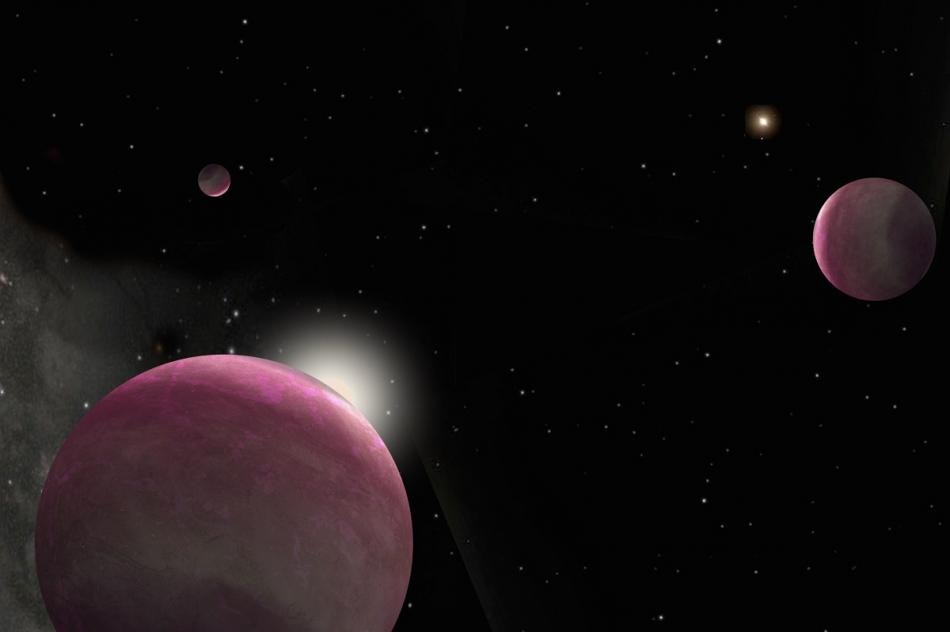Sep 1 2016
 Artist’s conception of the binary system with three giant planets discovered in this study. One star hosts two planets and the other hosts the third. The system represents the smallest-separation binary in which both stars host planets that has ever been observed. Image is courtesy of Robin Diene
Artist’s conception of the binary system with three giant planets discovered in this study. One star hosts two planets and the other hosts the third. The system represents the smallest-separation binary in which both stars host planets that has ever been observed. Image is courtesy of Robin Diene
Scientists from Carnegie have identified three giant planets in a binary star system composed of stellar ''twins'' that are siblings of the Sun. One star hosts two planets and the third one is hosted by the other star.
Planets that were never observed before are present in the smallest-separation binary, which is represented by the system. The findings could help to describe the impact that giant planets like Jupiter have over the architecture of a solar system.
The Astronomical Journal has accepted to publish these findings.
Discoveries recently made through the study of exoplanetary systems highlight where on the continuum of ordinary to unique our Solar System layout falls. Several planets that are extremely different from what is observed in the solar system have been revealed by planet hunters.
Super-Earths, which are the commonly detected exoplanets, are smaller than Uranus or Neptune but bigger than our planet. Existing statistics reveal that Jupiter-sized planets are very rare, as they have only been detected around a limited percentage of stars.
This is significant as Jupiter’s gravitational pull was expected to be a major influence on the Solar System’s architecture in its development period. The shortage of Jupiter-like planets could describe why our home system varies from the others that have discovered to date.
This new discovery is considered to be the very first exoplanet detection based only on data obtained from the Planet Finder Spectrograph (PFS), created by Carnegie scientists and mounted on the Magellan Clay Telescopes at Carnegie’s Las Campanas Observatory.
PFS is capable of detecting big planets with long-duration orbits or orbits that are extremely elliptical instead of circular, including the three new planets identified in this twin star study. This specific capability is a result of the long observing baseline of PFS. Observations have been made for six years.
The team, headed by Johanna Teske, included many scientists from both the Carnegie Observatories in Pasadena, CA, and the Department of Terrestrial Magnetism in Washington, DC, also including Steve Vogt of the University of California Santa Cruz.
We are trying to figure out if giant planets like Jupiter often have long and, or eccentric orbits. If this is the case, it would be an important clue to figuring out the process by which our Solar System formed, and might help us understand where habitable planets are likely to be found.
Johanna Teske, Carnegie Science
The twin starts are called HD 133131A and HD 133131B. Two moderately eccentric planets are hosted by the former star, where one is about 1 and a half times Jupiter’s mass, at a minimum, and the other is just more than half of Jupiter’s mass, at a minimum. One moderately eccentric planet comprising a mass of almost 2.5 times Jupiter’s is hosted by the other planet.
Both of the stars are separated by just 360 astronomical units (AU). One AU refers to the distance between the Earth and the Sun. This is considered to be majorly close for twin stars with detected planets orbiting the individual stars.
The next-closest binary system that hosts planets comprises of two stars that are almost 1,000 AU apart.
The system is far more unusual as both of the stars are “metal poor” - most of their mass is helium and hydrogen, compared to other elements like oxygen or iron. The stars that host giant planets are often rich in metals.
This discovery is remarkable as only six other metal-poor binary star systems comprising exoplanets have been discovered.
Teske used an accurate analysis to highlight that the stars are not identical “twins” as earlier thought, but have somewhat varied chemical compositions, which make them more similar to the stellar equivalent of fraternal twins.
This could point out that a few baby planets were swallowed by one star in its early life, slightly modifying its composition. However, the gravitational forces of the identified giant planets that remained may have had a major effect on the small planets that are fully-formed, tossing them towards the star or out into space.
The probability of finding a system with all these components was extremely small, so these results will serve as an important benchmark for understanding planet formation, especially in binary systems.
Johanna Teske, Carnegie Science
Teske’s team also included Carnegie’s Stephen Shectman, Matías Díaz, Paul Butler, Jeffrey Crane, and Pamela Arriagada.